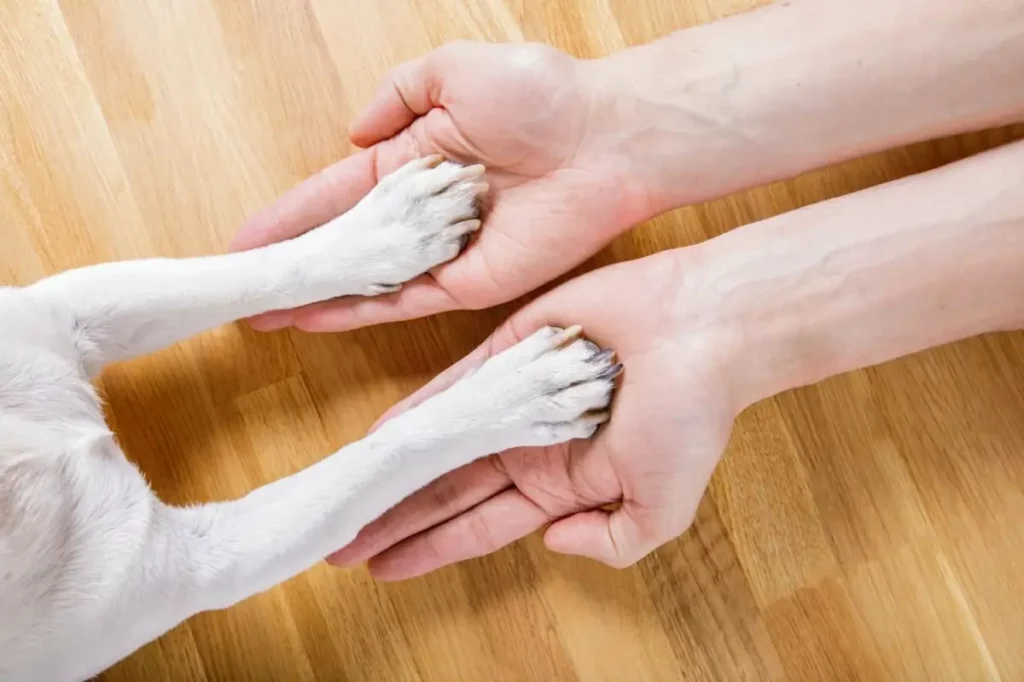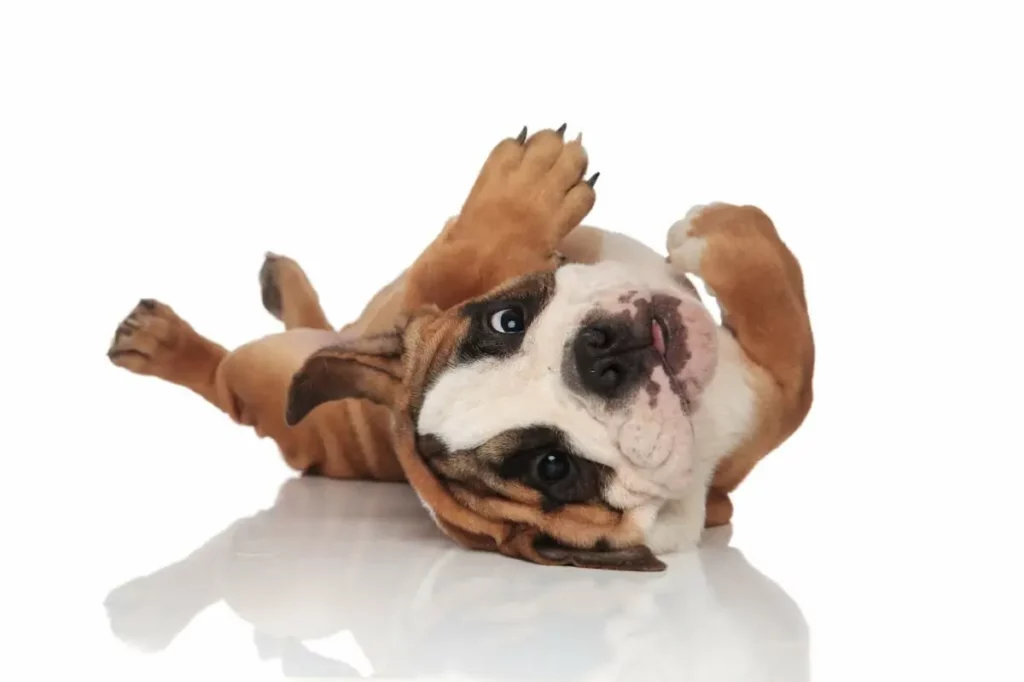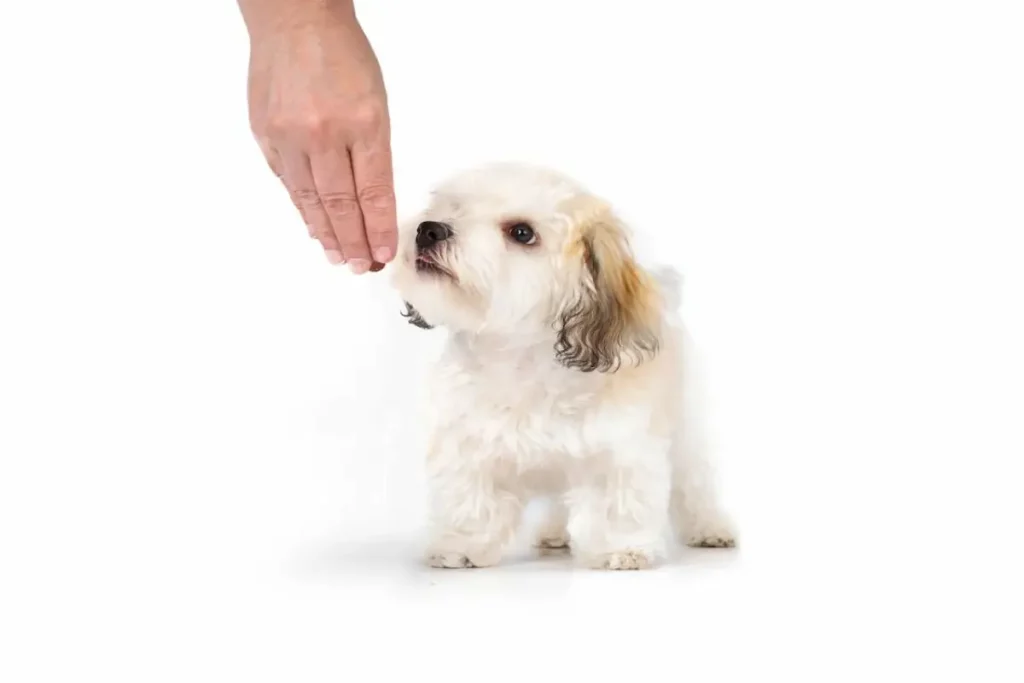You get home from work only to have your adorable furballs jump up to put their paws on you. This is certainly not an uncommon dog action, but what is it exactly that they want? Are they trying to tell you something? What’s the motive behind why do dogs put their paws on you?
Dogs put their paws on you as a form of communication. What they are communicating can be them signaling to you the unconditional love they have for you. It can also mean it is time for some bonding, such as playing a game of fetch, going out for a walk, or receiving nice belly rubs. Another reason is they are telling you it’s time for them to eat.
When you get down to it, there are really a variety of different reasons for this particular behavior and yes, it typically involves trying to communicate a message he is trying to get across.
Today we will go over what that message could possibly be, if and when it should be considered acceptable behavior, and how to rectify the situations where it is not.
Here are the most common 12 things your dog is trying to say when he puts his perfect puppy paws on you.
Why Do Dogs Put Their Paws On You?
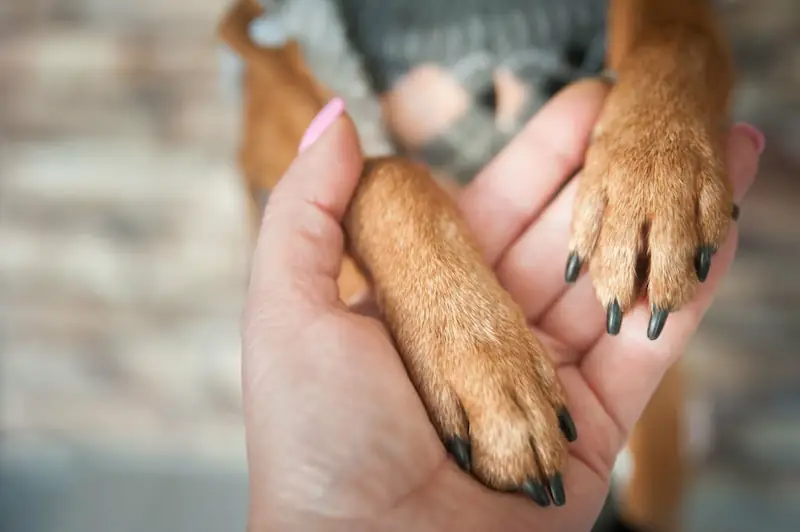
12. He’s Looking For Some Lovin
One of the most well-known reasons for this universal doggy gesture is to let you know that your pooch is in need of some love, whether it be in the form of a good petting session, some sloppy kisses, or a nice, relaxing belly rub, he is passing along the news that it is, in fact, McLovin time. P.S. This could be the perfect opportunity for a big, furry cuddle!
11. Asserting Dominance
If the paw contact feels slightly aggressive in nature, this could be his well-meaning way to assert his dominance over you. He is pretty much saying to you, “Stand down hooman! I am boss!”. He is more likely to do this when he is in the presence of others (human or canine). He is likely checking his limits and seeing just how far he can push the boundaries. In this case, the behavior should quickly be nipped in the bud.
10. He Is Hungry
Dogs will also sometimes use their paws to let you know that they are hungry and that it is time for dinner or a snack. One of the most noticeable instances of him doing this is when you are eating and Fido decides he needs a share. While pawing as a simple signal for his own hunger might not be an issue, doing so aggressively, especially while you are trying to eat should not be permitted.
Related: WHY DO DOGS CROSS THEIR PAWS: 6 LIKELY REASONS
09. He’s Nervous Or Fearful
Not unlike the relationship between mother and child, one between a dog and his human is one where he looks to you for his safety, protection, and assurance. This means that when he is scared, nervous, and/or fearful, he will likely notify you that he needs your support and he will sometimes do this by using his paws. This is natural and can have a calming, comforting effect on your scared dog. Reassure and comfort him.
08. He Is Experiencing An Anxiety Or Panic Attack
If you have ever been an adoptive parent of a dog with a severe thunder phobia, you will certainly recognize this communicative display. Many times when a dog is in need of calming, particularly while experiencing anxiety, they will signal this by (sometimes frantically) placing their paws on you. Many times these symptoms can be soothed by a loving embrace from their favorite human, however, there are some medications that your veterinarian could recommend to treat difficult cases.
07. Showing Ownership
Yep, that’s right, your dog sometimes feels the need to make it abundantly clear that you are HIS human. Sometimes his paws on you are simply him showing his proud ownership. He is letting everyone know that he is the proud owner of the best human in the whole world! So long as he does not try to become the ‘boss’ of the household, this can be seen as a more endearing behavior than one in need of correcting.
06. Offering Support
Anyone who has a dog knows that they seem to just know when they’re needed. When you are down, sad, or depressed, Fido is typically the first to notice and offer support. Typically, putting his head, or paws, in your lap is his way of saying it is all going to be okay and that he is there for you. These moments help to fortify the bond between you and your dog. His support should always be encouraged and appreciated.
05. Trying To Alert You To Something Wrong
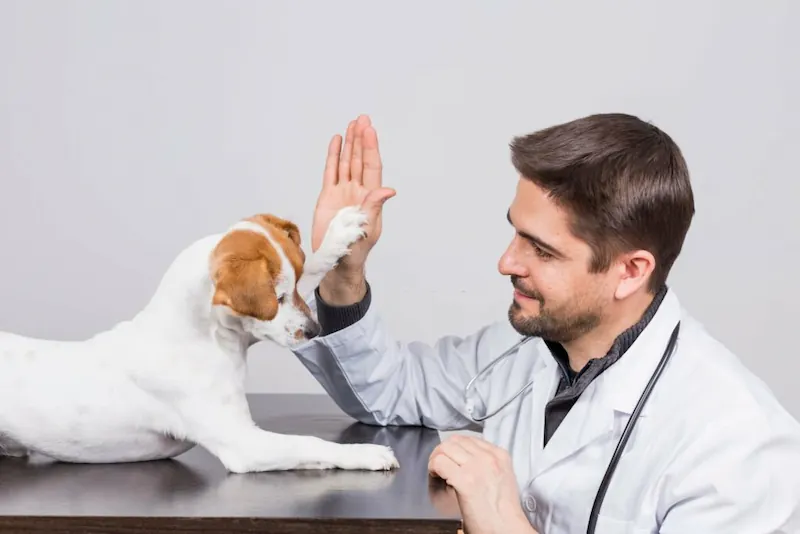
Your dog is simply unable to communicate verbally that something just isn’t right. Whether it is an illness, injury, or something else, sometimes those paws mean that he needs you to know that something is wrong. If he is being persistent about pawing you, you may want to consider that there may be an underlying issue at play.
04. In Protest
When you are petting the cat and the dog is having none of that, he will sometimes use his paws in protest. This is to let you know that this behavior is unacceptable and will not be tolerated in any way, shape, or form. He might also use his paws to push away the competition, which is fine, so long as nobody gets hurt!
03. He Is In Agreement With You Or Your Actions
Dogs do not get near enough credit for how intuitive and smart they can be. They just somehow know when something is up but since they cannot tell you that they agree with you, they use the gesture of placing their paws on you instead.
02. Showing Appreciation
In addition to sloppy kisses, dogs can also use their paws to show just how much they appreciate everything you do for them. They can’t exactly tell you, “Hey, Hooman, thanks for all that you do for me!” so they show you in one of the only ways they know how to. This behavior is best responded to with a great big hug.
01. To Signal Bonding Time
Saving the best for last. One of the most natural and common reasons for this sweet doggy gesture is to subconsciously signal to you that it is time for bonding. This can entail a walk, a game of fetch, or a quick cuddle on the sofa. The main point that they are trying to convey is that they want some quality human + canine time.
Should You Allow And/Or Encourage This Behavior?
Whether you allow and/or encourage their pawing habits, really ends up being down to personal preference and the different circumstances. If you have small children or elderly loved ones in the home, or if he is doing it in inappropriate situations, you may not want your dog jumping and pawing whatsoever. While it is a natural form of communication for them, your dog can more than likely be trained to not practice these behaviors.
How To Train Your Dog To Stop Pawing
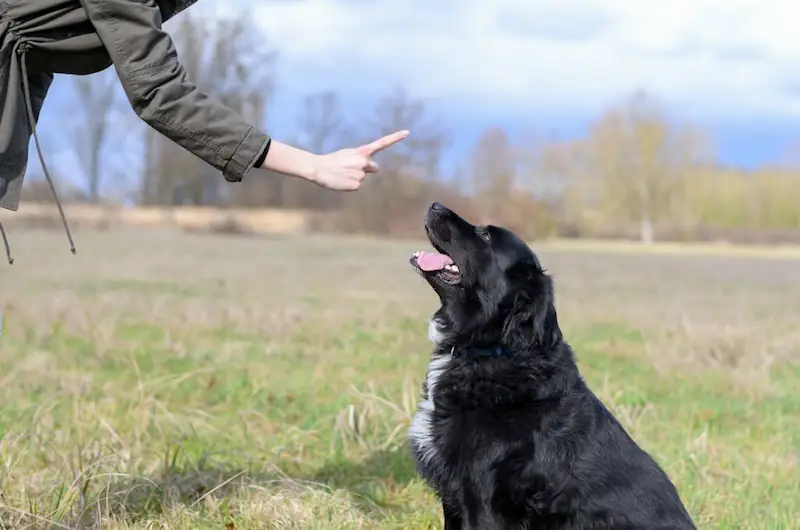
Sometimes pawing simply cannot be allowed. If you have grandma living with you, and Fido is a massive St. Bernard, pawing could be a dangerous game. In these instances, it is best to either teach your dog to completely stop pawing, or to learn when and where it is appropriate.
- Total Cessation: While not an easy task by any means, it is possible to teach your old dog new tricks, including training him to not paw at people. He has likely already been conditioned to paw and it is going to take a bit of work to break the habit.
- Do not encourage him, if he starts pawing, gently remove his paws from contact with a firm ‘No’.
- Redirect his attention. When he starts to paw at you, identify the reason (hunger, dominance, etc.) but do not give in to his demand. Instead, redirect his attention to a quick game of fetch. Once his attention has been diverted you can respond to his initial request.
- Whatever you do, don’t give in to his behavior. This will ensure that the behavior continues. Never reward bad (or unwanted) behavior.
- By Command: If you are not looking to stop him from pawing altogether, you can teach him to cease doing so with certain people or on command.
- Teach him a cue, such as ‘Enough!’ or ‘Refrain!’.
- Consistency is key with this modification technique. You must stick with it or end up confusing your dog, which can result in unwanted behaviors. It’s a vicious cycle.
Final Thoughts
It really comes down to the individual needs and personalities, of each pet in each household. However, you should keep in mind that pawing can be some dogs’ only effective way to communicate their wants and needs.
If there is no valid reason for banning the behavior completely it might be a better idea to consider modifying it instead.
By all means, establish rules and boundaries and set firm limits but let him be communicative. It is likely to be one of the most beautiful, loving, and purest friendships that you’ll ever have.
FAQs About: Why Do Dogs Put Their Paws On You
Why does my dog constantly put his paws on me?
Constant pawing can be a sign of affection, attention-seeking, or a desire for interaction.
Is it okay to let my dog paw at me?
While occasional pawing is normal, training and setting boundaries help manage excessive pawing.
How can I train my dog to stop pawing excessively?
Positive reinforcement, redirection, and consistency are key to training dogs to curb excessive pawing.
What should I do if my dog’s pawing behavior changes suddenly?
Sudden changes may indicate discomfort or health issues. Consult a vet if behavior shifts unexpectedly.
Can pawing be a sign of pain or discomfort in dogs?
Yes, changes in pawing behavior can be indicative of pain or discomfort. Monitor for other signs and consult a vet if needed.
why does my dog put his paw on me
Your dog paws at you primarily to be close to you, to show you affection, and to signal that he wants attention from you. Remember that dogs do not communicate with words, but often express themselves through their body language.
why do dogs give you their paw?
They can notice your mood, your emotions, and even subtle signals that you need comfort or support. If your dog sees that you are sad, stressed, or in need of reassurance, he may offer you his paw as a sign of comfort and compassion.
Did you find this post useful? Save THIS PIN to your Dog board on Pinterest 🙂

